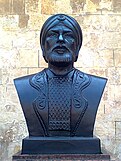Wikipedia:Main Page history/2024 October 24
From today's featured article
Umbriel is the third-largest moon of Uranus. It was discovered on October 24, 1851, by William Lassell. Named after a character in the 1712 poem The Rape of the Lock by Alexander Pope, Umbriel is composed mainly of ice with a substantial fraction of rock. It may be differentiated into a rocky core and an icy mantle. Its surface, the darkest among Uranian moons, appears to have been shaped mostly by impacts, but the presence of canyons suggests early endogenic processes. This shows Umbriel may have undergone an early endogenically driven resurfacing event that erased its older surface. Covered by numerous impact craters reaching 210 km (130 mi) in diameter, Umbriel is the second-most heavily cratered satellite of Uranus after Oberon. Like all moons of Uranus, Umbriel likely formed from an accretion disk that surrounded the planet just after its formation. The only close study of Umbriel was conducted in January 1986 by Voyager 2, which captured images of about 40 percent of its surface during the spacecraft's flyby of Uranus. (Full article...)
Did you know ...
- ... that for nearly 65 years, Wuhan trolleybus route 1 (pictured) included a loop around a statue of Sun Yat-sen?
- ... that a Stradivarius cello once owned by Ernest de Munck is now named after him?
- ... that the Félag hljómplötuframleiðenda tried to close the file-sharing website Istorrent in 2007–2008, but the Supreme Court of Iceland dismissed the case?
- ... that a banker was named the prime minister of Equatorial Guinea after his predecessor resigned during an economic crisis?
- ... that while shooting his first short film, Jean-Luc Godard was barred from his mother's funeral for stealing?
- ... that Brenden Bates "loves moving people against their will"?
- ... that a fort in Baguia was restored to be converted into tourist accommodation?
- ... that The New York Times Simulator was inspired by its creator's frustration with media coverage of the Israel–Hamas war?
In the news
- Moldova votes to amend its constitution to include the aim of becoming a European Union member state.
- Yahya Sinwar (pictured), the leader of Hamas, is killed in a firefight with Israeli forces in Gaza.
- The Nobel Memorial Prize in Economic Sciences is awarded to Daron Acemoglu, Simon Johnson, and James A. Robinson for their comparative studies of prosperity between nations.
- The Europa Clipper spacecraft is launched to investigate Europa, an icy moon of Jupiter.
On this day
October 24: Simchat Torah begins at sunset (Jewish diaspora)
- 1260 – Qutuz (bust pictured), the sultan of Egypt, was assassinated and replaced by fellow Mamluk leader Baybars.
- 1796 – War of the First Coalition: The Battle of Schliengen was fought between the French and Austrian armies, who both claimed victory.
- 1945 – The Charter of the United Nations entered into force after being ratified by the five permanent members of the Security Council and a majority of the other signatories.
- 1975 – In protest against wage discrepancy and unfair employment practices, 90 percent of Iceland's female population went on strike for a day.
- 2003 – The inaugural Afro-Asian Games opened in Hyderabad, with 2,040 athletes from 96 nations competing.
- Tycho Brahe (d. 1601)
- Peng Dehuai (b. 1898)
- Letitia Woods Brown (b. 1915)
- Regina Purtell (d. 1950)
Today's featured picture

|
|
The mortuary temple of Hatshepsut is a mortuary temple built during the reign of Hatshepsut, a pharaoh of the Eighteenth Dynasty of Egypt, around the 15th century BC. Located opposite the city of Luxor, the temple's three terraces rise above the desert floor and into the cliffs of Deir el-Bahari. Hatshepsut's tomb lies inside the same massif, capped by El Qurn, a pyramid for her mortuary complex. At the edge of the desert, one kilometre (0.6 miles) east, connected to the complex by a causeway lies the accompanying valley temple. Across the river Nile, the whole structure points towards the monumental Eighth Pylon, Hatshepsut's most recognizable addition to the temple of Karnak. The temple's twin functions are identified by its axes: its main east–west axis served to receive the barque of Amun-Re at the climax of the festival, while its north–south axis represented the life cycle of the pharaoh from coronation to rebirth. This aerial photograph shows the reconstructed mortuary temple of Hatshepsut, viewed from the southeast. Photograph credit: Diego Delso
Recently featured:
|
Other areas of Wikipedia
- Community portal – The central hub for editors, with resources, links, tasks, and announcements.
- Village pump – Forum for discussions about Wikipedia itself, including policies and technical issues.
- Site news – Sources of news about Wikipedia and the broader Wikimedia movement.
- Teahouse – Ask basic questions about using or editing Wikipedia.
- Help desk – Ask questions about using or editing Wikipedia.
- Reference desk – Ask research questions about encyclopedic topics.
- Content portals – A unique way to navigate the encyclopedia.
Wikipedia's sister projects
Wikipedia is written by volunteer editors and hosted by the Wikimedia Foundation, a non-profit organization that also hosts a range of other volunteer projects:
-
Commons
Free media repository -
MediaWiki
Wiki software development -
Meta-Wiki
Wikimedia project coordination -
Wikibooks
Free textbooks and manuals -
Wikidata
Free knowledge base -
Wikinews
Free-content news -
Wikiquote
Collection of quotations -
Wikisource
Free-content library -
Wikispecies
Directory of species -
Wikiversity
Free learning tools -
Wikivoyage
Free travel guide -
Wiktionary
Dictionary and thesaurus
Wikipedia languages
This Wikipedia is written in English. Many other Wikipedias are available; some of the largest are listed below.
-
1,000,000+ articles
-
250,000+ articles
-
50,000+ articles




